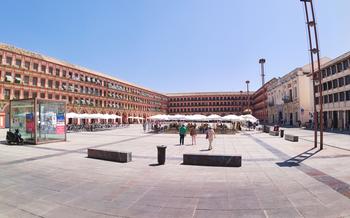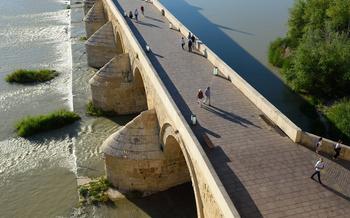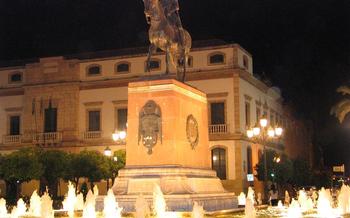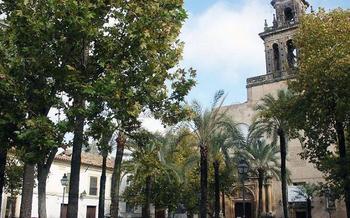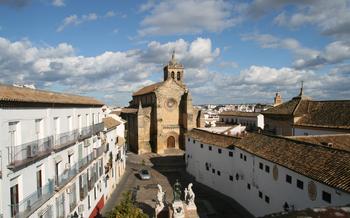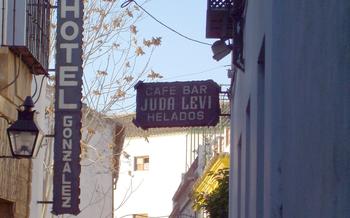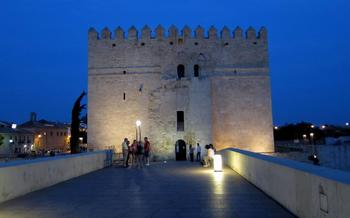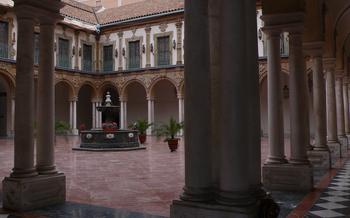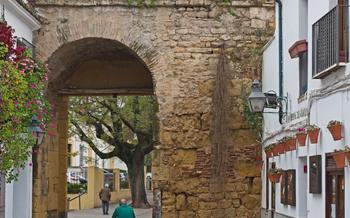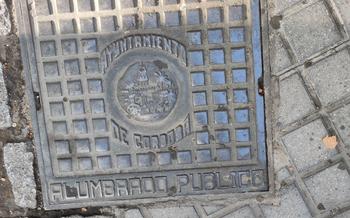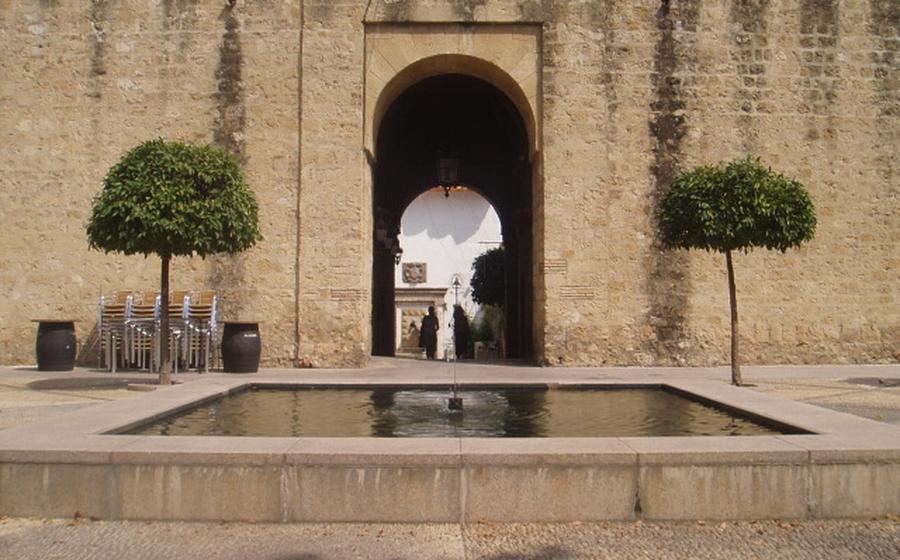
Arco de la Luna
- A City of History
- Marvel of Islamic Architecture
- Witness to Changing Times
- Gateway to the Alcazar
- Exploring the Jewish Quarter
- A Walk Through History
- Panoramic Views
- The Soul of Córdoba
- Festivals and Celebrations
- Souvenirs and Local Crafts
- Culinary Delights
- Photography Opportunities
- Practical Information
- Insider Tip
A City of History
Córdoba, a city steeped in rich history and cultural heritage, stands proudly in southern Spain. Its origins can be traced back to the Roman era, when it served as a strategic settlement on the banks of the Guadalquivir River. During the 8th century, Córdoba flourished under Islamic rule, becoming the capital of the Umayyad dynasty and a vibrant center of art, science, and culture. In the 13th century, the city was reconquered by Christian forces, leaving behind a captivating blend of Islamic and Christian influences that continue to shape its identity today. The Arco de la Luna, a majestic gateway located in the heart of Córdoba, stands as a testament to the city's diverse past and its enduring legacy as a crossroads of civilizations.
Marvel of Islamic Architecture
The Arco de la Luna stands as a testament to the exquisite craftsmanship and artistry of Islamic architecture. Constructed in the 9th century, the gate showcases intricate carvings and decorations that blend Islamic and Romanesque elements. Its horseshoe arch, adorned with vegetal and geometric motifs, frames a stunning view of the city. The combination of these architectural styles reflects Córdoba's rich cultural heritage and its position as a crossroads of civilizations.
The gate's construction demonstrates the advanced engineering skills of the period. Its sturdy walls and defensive features, including a machicolation, ensured the protection of the city. The gate's design also incorporates symbolic elements, such as the crescent moon and star, which represent the Islamic faith.
The Arco de la Luna serves as a reminder of the significant role that Islamic architecture played in shaping Córdoba's urban landscape and cultural identity. Its intricate design and enduring legacy continue to captivate visitors, offering a glimpse into the city's rich and diverse past.
Witness to Changing Times
Throughout its existence, the Arco de la Luna has borne witness to Córdoba's tumultuous history and changing fortunes. During the Islamic period, it served as a crucial entry point to the city, providing access to the Alcázar and the Jewish Quarter. As Córdoba transitioned from Islamic to Christian rule, the gate continued to play a significant role, transitioning from a symbol of Islamic power to a representation of the city's Christian heritage.
Over the centuries, the gate has adapted to the city's evolving needs and circumstances. It has undergone renovations and modifications, reflecting the changing architectural styles and tastes of different eras. Despite these changes, the gate has retained its essential character, standing as a testament to Córdoba's rich and multifaceted past.
The Arco de la Luna's surroundings have also undergone significant transformations. Once nestled amidst the bustling streets of the Jewish Quarter, the gate now finds itself in a more modern urban setting. The narrow, winding alleys have given way to wider streets and plazas, but the gate remains a tangible link to the city's medieval past.
Gateway to the Alcazar
In close proximity to the Arco de la Luna stands the majestic Alcázar of Córdoba, a symbol of the city's regal past. Once serving as the residence of the Christian monarchs who succeeded the Moorish rulers, the Alcázar holds a significant place in Córdoba's history. The Arco de la Luna acted as a grand entrance to this royal palace, welcoming visitors and dignitaries alike. Through this gate, they would step into the opulent courtyards, admire the intricate architecture, and experience the rich legacy of Córdoba's diverse rulers. The gate's strategic placement underscores its importance as a gateway to power and prestige, connecting the city's past with its present.
Exploring the Jewish Quarter
The Arco de la Luna stands as a gateway to Córdoba's captivating Jewish Quarter, a historic neighborhood steeped in cultural significance. Once home to a thriving Jewish community, this quarter retains its charm and heritage through its intricate architecture, narrow streets, and well-preserved synagogues.
Visitors can embark on a journey through time as they explore the quarter's synagogues, such as the renowned Synagogue of Córdoba, which boasts exquisite Mudejar-style architecture. The Jewish Museum of Córdoba, housed in a former synagogue, offers a glimpse into the community's rich history, traditions, and contributions to the city's cultural fabric.
Strolling through the quarter's labyrinthine streets, lined with whitewashed houses and adorned with colorful flower pots, is an experience in itself. Visitors can discover hidden courtyards, charming plazas, and unique shops showcasing traditional crafts and local products, making it an ideal place to find souvenirs and support local artisans.
A Walk Through History
The Arco de la Luna stands as a testament to Córdoba's rich past, forming an integral part of the city's historic center. Its cobbled streets and whitewashed houses exude a timeless charm, inviting you to step back in time and explore the city's hidden treasures. Wander through the labyrinthine alleyways, discovering ancient churches, quaint plazas, and bustling markets. Admire the intricate carvings adorning the buildings, each telling a story of Córdoba's diverse cultural heritage. Embrace the opportunity to delve into the city's past, uncovering the stories that lie beneath its sun-kissed facade. Immerse yourself in the city's vibrant energy, where history and modernity seamlessly intertwine, creating a captivating tapestry of experiences.
Panoramic Views
For an unforgettable experience, climb the tower of the Arco de la Luna and be rewarded with breathtaking panoramic views of Córdoba. Overlooking the city and its iconic landmarks, the vista from the top is simply mesmerizing. Take in the grandeur of the Mezquita-Catedral, the Guadalquivir River meandering through the city, and the distant hills providing a picturesque backdrop. Capture stunning photographs of the city's skyline, showcasing the blend of architectural styles that have shaped Córdoba's rich history. Whether you're a photography enthusiast or simply seeking a unique perspective of the city, the panoramic views from the Arco de la Luna will leave you in awe.
The Soul of Córdoba
The Arco de la Luna stands as a proud and enduring symbol of Córdoba, embodying the city's rich cultural heritage and vibrant spirit. It is a testament to the city's resilience, having witnessed countless historical events and transformations. The gate represents the essence and identity of Córdoba, serving as a gateway to its past, present, and future.
For centuries, the Arco de la Luna has been a focal point for locals and visitors alike, attracting those who seek to immerse themselves in the city's captivating history and culture. It invites travelers to step back in time, to imagine the bustling streets of medieval Córdoba, when the gate served as a strategic entrance to the city. The gate's intricate carvings and decorations whisper tales of the city's Islamic and Romanesque heritage, providing a glimpse into its diverse past.
Visiting the Arco de la Luna is not merely a historical journey; it is an emotional experience that stirs the soul. The gate evokes a sense of awe and wonder, reminding visitors of the enduring power of architecture and the significance of preserving cultural landmarks. As they stand beneath its imposing arch, travelers are transported to a realm where history, culture, and beauty converge, leaving an imprint on their hearts that will last a lifetime.
Festivals and Celebrations
The Arco de la Luna is not just a historical monument but also a vibrant part of Córdoba's cultural scene. During local festivals and celebrations, the gate is illuminated with colorful lights and decorated with festive ornaments, creating a magical atmosphere. Visitors can witness the city's vibrant spirit and participate in the lively festivities that take place throughout the year. These events offer a unique opportunity to immerse oneself in the rich traditions and customs of Córdoba, making the experience of visiting the Arco de la Luna even more memorable.
Souvenirs and Local Crafts
Around the Arco de la Luna, you'll find a treasure trove of shops and stalls selling unique souvenirs and local crafts. These charming boutiques offer a delightful array of handmade items that beautifully capture the essence of Córdoba's rich cultural heritage. From intricate pottery and colorful ceramics to delicate lace and traditional textiles, there's something to suit every taste and budget.
As you browse through the stalls, you'll discover a world of craftsmanship that has been passed down through generations. Local artisans pour their heart and soul into creating these exquisite pieces, ensuring that each one is a true work of art. Whether you're looking for a special gift for a loved one or a unique memento to remind you of your time in Córdoba, you're sure to find something truly special here.
By supporting these local businesses, you're not only taking home a piece of Córdoba's culture but also contributing to the preservation of traditional crafts. So, be sure to set aside some time to explore the shops and stalls near the Arco de la Luna and discover the hidden treasures that await.
Culinary Delights
In the vicinity of the Arco de la Luna, visitors can embark on a culinary adventure, savoring the tantalizing flavors of traditional Cordoban cuisine. An array of local restaurants and tapas bars awaits, tempting taste buds with an array of delectable dishes. Indulge in the creamy richness of salmorejo, a chilled tomato soup topped with jamón serrano and hard-boiled eggs. Delight in the crispy, golden flamenquín, a pork loin rolled in breadcrumbs and fried to perfection. Complement your meal with a glass of refreshing fino sherry, produced in the nearby Montilla-Moriles region. As you savor these culinary delights, immerse yourself in the vibrant atmosphere of Córdoba's culinary scene, where the aromas of traditional cooking mingle with the lively chatter of locals and visitors alike.
Photography Opportunities
The Arco de la Luna, with its striking architecture, ornate carvings, and picturesque surroundings, is a photographer's paradise. Capture the gate's beauty and grandeur from various angles, highlighting its intricate details and the interplay of light and shadow. Frame the gate against the clear blue sky or the warm glow of sunset, creating dramatic and captivating images. Don't miss the opportunity to capture the gate's reflection in the waters of the nearby river, adding a touch of serenity and symmetry to your shots. Remember to experiment with different perspectives and compositions to create unique and Instagram-worthy photographs that showcase the essence of this historic landmark. Share your travel experiences through photography and inspire others to discover the wonders of Córdoba.
Practical Information
Opening Hours and Admission Fees
- The Arco de la Luna is open to visitors from 10 am to 6 pm, Tuesday through Sunday.
- Admission to the gate is free of charge.
Accessibility
- The gate is accessible to visitors with disabilities via a ramp.
- There are also accessible restrooms available on-site.
Guided Tours and Audio Guides
- Guided tours of the gate are available in English and Spanish.
- Audio guides are also available in multiple languages.
- Tours and audio guides can be booked in advance or on-site.
Planning Your Visit
- To make the most of your visit, plan to spend at least 30 minutes exploring the Arco de la Luna.
- Combine your visit with other attractions in the area, such as the Alcázar of Córdoba or the Jewish Quarter.
- Be sure to bring your camera to capture the gate's beauty and grandeur.
Insider Tip
For an unforgettable experience, visit the Arco de la Luna at sunset. As the sun dips below the horizon, the gate is bathed in a warm, golden glow, creating a magical atmosphere. The surrounding buildings and streets take on a different character, casting long shadows and creating a sense of mystery. With fewer crowds at this time of day, you can soak in the beauty of the gate and its surroundings without the hustle and bustle. Afterward, explore the nearby streets, which come alive in the evening with locals and tourists alike. Discover hidden gems such as charming boutiques, traditional restaurants, and lively bars. Combine your visit to the Arco de la Luna with other nearby attractions, such as the Alcázar of Córdoba or the Jewish Quarter, to make the most of your time in this enchanting city.
